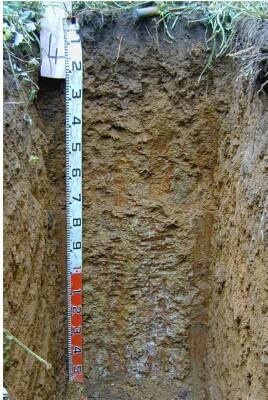ELL98 (Plot 4)
| Site: ELL98 (Plot 4) | Land Unit: Marl |
| General Land Unit Description: The flat surface of the Dundas Tablelands predominantly consists of Brown Chromosols and to a lesser extent Yellow Chromosols with a ferric horizon, typically occurring above the clay subsoil. The soil is commonly developed over a highly weathered mottled zone. This red and white mottling, sometimes referred to as ‘tiger mottles’, is thought to be the result of deep chemical weathering which occurred during the late Tertiary period. Red gums are the dominant vegetation found on this surface. Two year old Eucalyptus globulus plantation on ex-agricultural land |
Site Description:
| Geology: Cainozoic duricrust | Landform pattern: Gently undulating plain |
| Internal drainage: Imperfectly drained |
Soil Profile Morphology
| A1 | 0-15 cm | Dark brown (7.5YR3/2) loamy sand; weak granular structure (5-10 mm); very weak consistence when moist; common medium roots; clear and smooth transition to: |  |
| A2 | 15-40 cm | Yellowish red (5YR5/6) loamy sand; weak granular structure (5-10 mm); very weak consistence when moist; very many coarse ferruginous nodules; common very fine roots; clear and smooth transition to: | |
| Subsoil | |||
| B1 | 40-50 cm | Yellowish red (5YR5/8), fine sandy clay; moderate polyhedral structure (10-20 mm); very weak consistence when moist; common coarse ferruginous nodules; common fine macropores; areal porosity 1.5%; few very fine roots; clear and smooth transition to: | |
| B21 | 50-75 cm | Strong brown (7.5YR5/8) with many coarse distinct red (2.5YR4/6) mottles, light clay; strong polyhedral structure (20-50 mm) parting to strong polyhedral structure (5-10 mm); weak consistence when moderately moist; common coarse ferruginous nodules; few fine macropores; areal porosity 0.05%; few very fine roots; gradual and smooth transition to: | |
| B22 | 75-120 cm | Red (2.5YR4/6) with many very coarse prominent pinkish white (7.5YR8/1) mottles, light clay; strong polyhedral structure (20-50 mm) parting to strong polyhedral structure (10-20 mm); firm consistence when moderately moist; common coarse ferruginous nodules; few fine macropores; areal porosity 0.05%; few very fine roots. | |
| B22 | 120-150 cm | As above. | |
| 150-220 cm | As above. | ||
| 220-400 cm | Decomposing sedimentary material, tertiary sandstones and claystones, impeding layer to roots at 220 cm. | ||
Notes: Sampled by: Ian Sergeant, Paul Feikema and Martin Clark (24 October 2000)


